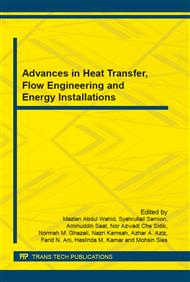p.382
p.392
p.401
p.406
p.420
p.427
p.432
p.438
p.443
Design, Simulation and Fabrication of Polydimethylsiloxane (PDMS) Microchannel for Lab-on-Chip (LoC) Applications
Abstract:
Microchannel of micron-to milimeter in dimension has been immensely used for fluid handling in transporting, mixing and separating biological cells in Lab-on-Chip (LoC) applications. In this paper, design, simulation and fabrication of Polydimethylsiloxane (PDMS) microfluidic channel are presented. The microchannel is designed with one inlet and outlet. A reservoir or chamber is proposed as an extra component in the microchannel design for ease of separating the intended biological cells as used in LoC magnetic separator and micro-incubator. Finite Element Analysis (FEA) shows laminar flow characteristic is maintained in the proposed microchannel design operating at volumetric flow rate between 0.5 to 1000 μL/min. In addition, pressure drop data across the microchannel are also been obtained from the FEA in determining the safe operation limit of the microchannel. The PDMS microchannels of two different chamber geometries have been successfully fabricated using replica molding technique from SU-8 negative photoresist mold. The fabricated SU-8 mold and the PDMS microchannel structure dimension are characterized using Scanning Electron Microscopy (SEM). Reversible bonding of PDMS microchannel layer and PDMS tubing layer has successfully accomplished by activating the PDMS surfaces using corona discharge. The preliminary testing of the microchannel confirmed its function for LoC continuous flow applications.
Info:
Periodical:
Pages:
420-424
Citation:
Online since:
January 2016
Authors:
Price:
Сopyright:
© 2016 Trans Tech Publications Ltd. All Rights Reserved
Share:
Citation:


